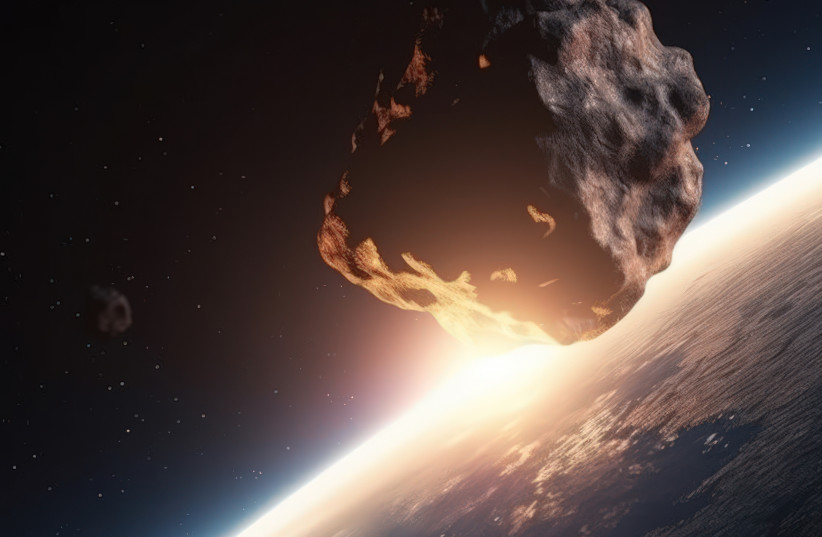A NASA spacecraft managed to alter an asteroid's shape by crashing into it as part of the DART planetary defense mission, a new study announced Monday.
This discovery of the altered shape of the asteroid Dimorphos has led scientists to conclude that the asteroid may not be a solid rock as many previously believed, but rather a rather weak pile of rubble shed from its neighboring asteroid, Didymous.
The findings of this study were published in the peer-reviewed academic journal Nature Astronomy.
A solid argument for a not-so-solid asteroid: Dimorphos deformos
In September 2022, NASA launched the groundbreaking Double Action Redirection Test (DART) mission in order to test out a safe, reliable, and effective means of protecting the Earth from an asteroid impact.
While the Earth is regularly hit with rocks from space, most burn up in the atmosphere, and those that don't tend to cause little to no damage, such as the asteroid that burnt up over Germany in January. However, larger asteroids would be able to make it through the atmosphere and could cause severe damage to the Earth, ranging from destroying a building to a global apocalypse-like scenario.

Asteroid impacts are therefore one of the single worst possible natural disasters that could occur, and mankind had no way of defending against it.
The DART mission was a way to fix this. Essentially, it would see a spacecraft launched at an asteroid and crash into it in order to alter its orbit ever so slightly. Even the slightest divergence in its orbit, assuming the asteroid was far enough away from the start, could mean the difference between an impact and an ordinary flyby.
To put it more simply, NASA punched an asteroid and made it move.
Since there were no targets headed our way, NASA sent the DART spacecraft to a 160-meter-wide asteroid known as Dimorphos, which orbits a much larger asteroid called Didymos, forming a binary system.
While researchers were able to verify that the mission was a success, scientists were still very interested in what happened to the asteroid. Numerous follow-up observations took place, and the European Space Agency's (ESA) Hera mission will see a probe launched to observe Dimorphos up close.
However, from what researchers are able to gather now, it seems that not only did it work, but that the impact may have been far greater than previously believed.
The researchers behind this study, which included researchers involved with the DART mission such as John Hopkins University's Andy Rivkin, were able to study the DART impact by modeling it with an advanced code for shock physics and with what they already knew about the asteroid thanks to DART and prior research.
The conclusion was that Dimorphos is no huge solid rock but rather a pile of rubble.
While that may seem strange to some, it's far more common than many people realize.
A rubble pile is a term in astronomy for any celestial body, like an asteroid, that is a literal pile of rubble rather than a single dense rock.
These types of asteroids are formed when an asteroid or moon gets smashed to pieces, only for self-gravitation to pull the pieces of rubble back together slowly.
Examples of rubble pile asteroids include the nearly kilometer-wide 162173 Ryugu and the 500-meter-wide 101955 Bennu. In fact, during NASA's OSIRIS-REx mission to the latter asteroid, the spacecraft actually touched onto the surface of the asteroid and nearly sunk in through the surface.

Bennu in particular was described by NASA at the time as having the consistency of a ball pit, and the researchers behind this new study think Dimorphos is likely the same. This is why the DART impact wouldn't have formed a crater. Rather, it would have slammed through the surface of the asteroid into its interior, the impact causing it to be wholly reshaped - something known as global deformation.
But scientists have long theorized that Dimorphos was a rubble pile asteroid, and if they're so common, what makes this discovery significant?
The reason is where the rubble making up Dimorphos came from.
Dimorphos is part of a binary asteroid system with the much larger Didymos. To put it in perspective, the 160-meter-wide Dimorphos is the size of around 1,084 iPhone 15s. Dydimos, however, is around 780 meters in diameter, and is therefore the size of over 5,284 iPhone 15s.
As the smaller one in the system, Dimorphos acts as Didymos's moon and natural satellite, orbiting around the larger asteroid. But it is now theorized that the source of Dimorphos's rubble comes from Didymos itself.
Over time, bits and pieces of Didymos would come off due to rotational shedding. Eventually, this ejected material would accumulate itself together, forming the rubble pile asteroid we know today.
Asteroids are very far away, with the Didymos system being one of the closest ones of its size. As such, without going there physically, scientists are limited in what they can learn about them. But this discovery gives significant insights into how binary systems like Didymos can form, and can help researchers prepare for future exploration missions and the field of planetary defense.
Because just because an asteroid may be a pile of rubble doesn't mean an impact won't still be catastrophic.
